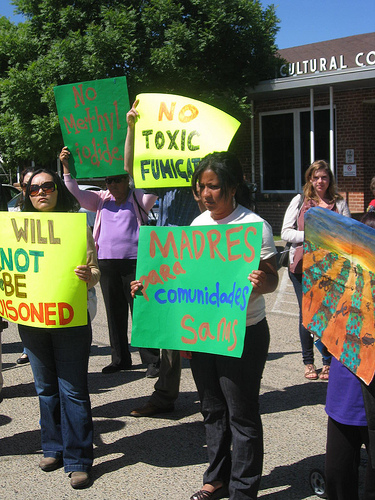 A group protesting methyl iodide last year. Photo: Pesticide WatchIt’s been a little over a year since methyl iodide — a known carcinogen that’s been made to work as a fumigant on industrial-scale conventional farms, and is especially likely to be used on strawberry farms — was approved for use in California.
A group protesting methyl iodide last year. Photo: Pesticide WatchIt’s been a little over a year since methyl iodide — a known carcinogen that’s been made to work as a fumigant on industrial-scale conventional farms, and is especially likely to be used on strawberry farms — was approved for use in California.
Methyl iodide is being seen as a replacement for the ozone-depleting methyl bromide, which will be phased out of use in the state by 2015. And while farmers appear to be holding off on using this highly toxic chemical (only a handful of applications have been recorded in the state so far), that fact hasn’t stopped anti-pesticide advocates from pushing the state’s Department of Pesticide Regulation (DPR) to reconsider the decision.
Thursday’s hearing, in response to a suit filed by California Rural Legal Assistance and Earthjustice against the state Attorney General’s Office and Arysta LifeScience Corp, the makers of the fumigant, offers a glimmer of hope. [Note: See tweets about the hearing on the KQED website or read this report on the trial from Amy Standen].
A group of advocates and lawyers held a press conference in Salinas on Wednesday to bring attention to the issue in advance of the hearing. There, a farmworker named Maria Vargas, from a group called Líderes Campesinas, spoke through a translator. She told The Californian: “We know that methyl iodide will principally affect women, children, and farmworkers, and, because we are in the fields, we will be most affected.”
It’s hard to say just how likely it is that today’s hearing will influence Gov. Jerry Brown or the DPR on the issue. But what’s really interesting to me — and it’s getting much less news coverage — is the simultaneous work being done by anti-pesticide advocates in Monterey County, the part of the state most likely to be impacted by the use of the fumigant.
Just last month, the Monterey County Board of Education passed a resolution opposing methyl iodide. A story in the local Monterey Herald (by Sara Rubin, a reporter who’s been following this issue closely) read:
Citing possible health risks for children attending Monterey County schools, six of the seven trustees Wednesday supported a resolution urging California lawmakers to repeal approval of methyl iodide, a pesticide the Environmental Protection Agency says could cause pulmonary edema, harm to the central nervous system and other effects.
This is a big deal in an agricultural county (and you can be sure not everyone is happy about it).
Now the same group of activists — a combination of teachers, farmworker advocates, the area’s League of Women Voters, and even some representatives from Planned Parenthood, who are making a connection between the fumigant and birth defects, as well as an array of other reproductive health issues — are asking the Monterey County Board of Supervisors to pass a similar resolution.
After an initial request in November (and the passage of a similar resolution in neighboring Santa Cruz County) the Board of Supervisors have agreed to a stakeholder meeting that will take place Friday, a day after the state-level hearing.
Monterey County is an important agricultural county — especially when it comes to strawberries; the crop is worth nearly $1 billion, and the strawberries grown there end up in grocery stores all over the nation. (California grows 86 percent of the fresh and frozen strawberries sold in the U.S., and nearly half of those are grown in the Salinas/Watsonville region.) It’s also where a large portion of methyl iodide would ultimately get used.
Dana Perls, an organizer with Pesticide Watch who has been working tirelessly to support these Central Coast communities, believes it would be “hugely symbolic” if Monterey County stands up and asks that last year’s decision be reconsidered.
“Monterey County has not always been the most liberal county,” she adds. “It has traditionally been a county that answers to the [conventional] ag community because it is so essential for the local economy. So it would be a pretty powerful statement for an agricultural county to side with public health.”


